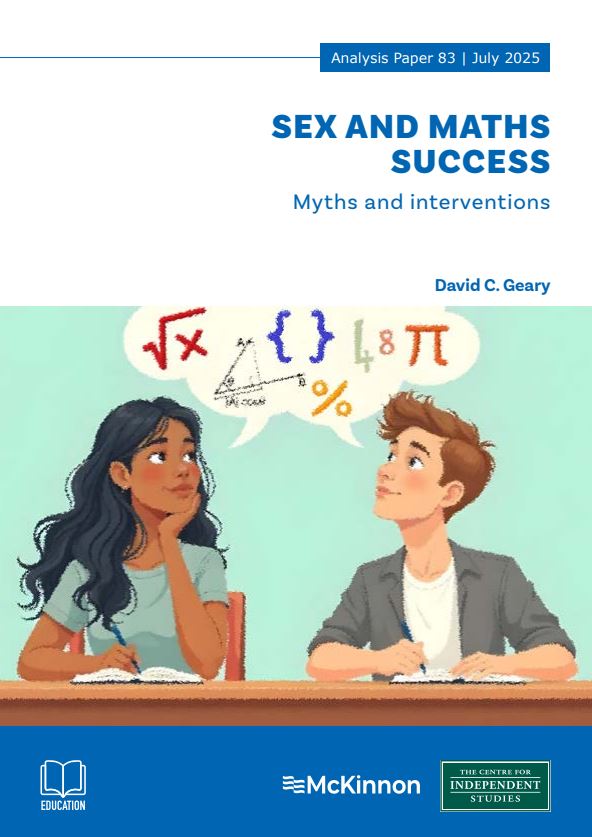
Executive summary
- Mathematical competencies at the completion of secondary school influence later educational and occupational opportunities, including entry into mathematics-intensive Science, Technology, Engineering, and Mathematics (STEM) careers. There are about three times more men than women in these STEM fields. The reasons for these differences remain vigorously debated, but would appear not to be determined fully by sex per se, as many think.
- The differences in STEM abilities increase with age. For the typical student population and especially during the primary or elementary school years, the average sex difference in mathematics performance is small and of minimal practical significance. Research also has found there are no discernable overall sex differences across some mathematical domains, such as arithmetic and algebra, although there are differences in some specific areas (e.g., word problems, number line).
- Boys and men are more variable in their mathematics performance which results in more of them at the low and high ends of performance. The ratio of boys to girls or men to women at the high-end ranges from 2 to 1 in the general population to more than 4 to 1 in highly select groups, such as mathematically gifted adolescents. Although not a select population, the numeracy results for general students from Australia reveal more boys than girls at the high end of numeracy performance from Year 3 to Year 9.
- Sex differences in academic strengths (i.e., best academic subject) are largest among the most academically able students and have implications for understanding sex differences in career choices. Throughout the world, more boys than girls have mathematics as their best academic area and more girls than boys have reading as their best academic area.
- A relation between some spatial abilities and performance in some mathematics domains is well established, as is boys’ and men’s advantages for most spatial skills. The combination provides boys and men with advantages in mathematics areas that involve a spatial component and for mathematics problems, such as word problems, that can be solved with a spatial strategy (e.g., diagramming relations depicted in the problem). However, girls with strong spatial abilities do as well on spatial-influenced mathematics measures as boys with the same level of spatial abilities, indicating that spatial abilities are the key factor rather than sex.
- Mathematics self-efficacy and utility beliefs represent students’ assessment of their competence in mathematics and the future usefulness of mathematics, respectively. Sex differences in self-efficacy and utility beliefs often favour boys, but are generally small. Moreover, the extent to which these are influenced by prior mathematics achievement, and influence later achievement, is not fully understood. Utility beliefs is one area in which important sex differences might emerge, whereby boys focus on the usefulness of mathematics as related to a future career and girls in terms of preparation for later mathematics courses. These differences, however, need further study.
- Higher levels of mathematics anxiety are related to lower mathematics achievement and avoidance of mathematics course taking. Cause-and-effect are not fully understood, but the relation between mathematics achievement and anxiety are likely reciprocal. These relations are found in both sexes, but the long-term effects might be more severe for girls and women because they experience higher levels of mathematics anxiety than do boys and men. Boys with high mathematics anxiety are likely to be as negatively affected as girls with the same level of anxiety, indicating that anxiety is the key factor and not sex.
- In-class attentive behaviour is consistently related to academic achievement, including mathematics. Girls are more attentive in classroom settings, and this might contribute to their advantages in learning and using school-taught algorithms for mathematical problem-solving. Boys’ advantage in spatial skills appears to compensate for their disadvantage in in-class attentive behaviour.
- There are promising interventions that could help reduce differences in some STEM abilities between males and females. These involve improving spatial skills and spatial-related mathematics competencies, as well as reducing mathematics anxiety. These might help reduce girls’ disadvantages in some mathematics domains, but this remains to be determined. There are classroom management interventions that will likely be helpful for some students (more boys than girls). For instance, explicitly teaching students, especially girls, how to represent mathematical information in a visuospatial format, as well as adopting classroom practices to keep boys more attentive in class.
- Misunderstanding of the reasons for sex differences in maths — the specific types, size and their extent — needs to be understood if there is to be worthwhile policy outcomes. There are some that think the solution to reducing any maths sex gap comes from sociology rather than science. This has led to a misguided belief that lifting girls’ maths outcomes can be achieved only through overcoming gendered societal norms and stereotypes, or demands for STEM gender equity.
- For instance, proponents of stereotype threat in STEM fields believe there are pervasive negative stereotypes about women’s abilities in these fields that in turn undermines their performance, even when there is no factual basis for the stereotype. The main problem with this argument is that the effects of stereotype threat on girls’ and women’s mathematics performance do not replicate, and even when effects are found, they are too small to be of practical significance. The same is true for related concepts including implicit bias and microaggressions.
- Improvement in national STEM capacity in mathematics-intensive fields will require identifying students who excel on traits that predict long-term success in these fields, including strong mathematics and spatial competencies. In contrast, the trend in many countries, including in Australia, is to focus on increasing diversity in STEM fields and not on selecting students with the highest potential for success. Tracking individuals into STEM programs and fields who are not strong on the long-term predictors of success in these fields will result in a diminution of the nations’ STEM capacities. One unfortunate consequence is that focus on predictive traits will likely result in a STEM demographic that includes more men than women in mathematics-intensive fields, rather than reflect the demographics of the general population.
Introduction
Academic competencies at the end of secondary school have a life-long influence on later educational and occupational opportunities and influence the ease of navigating the many complexities of life in the modern world.[1] Sex differences in reading are well established and are found in every country in which they have been systematically assessed, but differences in mathematics are more variable and often the focus of intensive debate.[2] As a result, a number of misconceptions have arisen about the nature and causes of sex differences in mathematics that will be discussed later in the paper.
Large-scale studies and meta-analyses that summarise results across studies reveal that, on average, sex differences in mathematics performance typically show a small advantage for boys,[3] but more pronounced differences are found at the lower and, particularly, the higher ends of the distribution.[4] The latter contributes to sex differences in entry into mathematics-intensive STEM (Science, Technology, Engineering, and Mathematics) careers and attendant debates regarding the proportion of women (about 25%) and men in these fields.[5] Sex differences in academic strengths (i.e., best academic subject) are not often considered in these debates, but are important, nonetheless. Students whose academic strength is mathematics (or science) are more likely to pursue a STEM-based education and career, whereas students whose academic strength is reading are more likely to pursue a humanities-based education and career, even if they have strong mathematics competencies.[6]
Sex differences in mean performance, at the high end, and as an individual strength are summarised in the first section below. The second is focused on the sex differences in spatial skills and their potential contribution to sex differences in some mathematical domains. The third section is focused on the relation between non-cognitive factors, such as mathematics anxiety, and sex differences in mathematics outcomes, whereas the fourth is focused on in-class attentive behaviour. Implications for mathematics interventions, which can help reduce sex differences, as well as STEM policies for the future, are covered in the final sections.
Sex Differences in Mathematics Outcomes
As noted, mean sex differences in mathematics are typically small and can vary from one topic or one nation to the next.[7] This is borne out by major international studies. In a multi-year and multi-national study of the academic outcomes of about 1.5 million adolescents on the Programme for International Student Assessment (PISA), Stoet and Geary found a small advantage for boys (d = .10 or a .10 standard deviation difference) across most, but not all, nations.[8] A difference of this magnitude means that there is a 54% chance of a randomly selected boy outperforming the average girl.
For another large-scale international assessment, Trends in International Mathematics and Science Study (TIMSS), Else-Quest and colleagues found no sex differences for 8th graders (Year 8 in Australia). Similarly, across multiple measures of the National Assessment for Educational Progress (NEAP, United States), Reilly and colleagues found that boys had a very small advantage in early grades and an advantage in 12th grade (Year 12) that was consistent with Stoet and Geary’s findings for the PISA (i.e., d = .10).[9]
On the basis of these patterns, it might be concluded that there are no substantive sex differences in mathematics that merit discussion. However, boys are more variable in mathematics outcomes which results in a larger proportion of them at the high end of performance. In an assessment of sex differences across various mathematics measures and grade or year levels, Hedges and Nowell found between 5% and 20% more variability in boys’ than girls’ performance.[10] They also found that there were about two boys for every girl in the top 5% of performance.
Reilly et al found a similar 2 to 1 ratio for 12th graders (Year 12) at the high end of the US National Assessment for Educational Progress (NAEP) performance, as did Stoet and Geary for the PISA.[11] A recent analysis of TIMMS data for Australia also revealed more boys than girls at the highest performance categories in Year 4 (10% of girls, 17% of boys) and Year 8 (9% of girls, 13% of boys).[12]
These types of measures, however, have a ceiling effect, that is, they are not difficult enough to discriminate among the truly mathematically gifted. One approach to addressing ceiling effects is to have younger students take exams that were designed for older students. Using this approach, Wai and colleagues found about a 4 to 1 ratio of adolescent (7th grade, Year 8) boys to girls among exceptional performers in mathematics (top .01 per cent).[13]
A student’s absolute level of academic achievement will influence tertiary and occupational choices, but so will academic strengths. For instance, a student who scores 20% higher than average on a mathematics achievement test is clearly doing well in mathematics, but if this same student scores 30% higher than average on a reading achievement test, then this student’s academic strength is reading. As mentioned, a consideration of academic strengths is important because they represent the student’s comparative advantage that in theory and in practice will influence educational and career choices.[14]
A set of studies across multiple waves of PISA performance for mathematics, science literacy, and reading comprehension, revealed that boys are more likely to have mathematics or science as an academic strength and girls to have reading as an academic strength.[15] There were more girls than boys with reading as an academic strength in every assessed country, and more boys than girls with either mathematics or science as an academic strength in almost all countries.
Across nations and for general student populations, 52% of girls and 20% of boys had reading as an academic strength as compared to 25% and 42% of girls and boys, respectively, with mathematics as an academic strength; science was the academic strength of the remaining students.14 The sex difference in academic strengths is larger for more select populations. Wai and colleagues explored this in a series of analyses of mathematics and verbal abilities in large samples of gifted adolescents. One analysis focused on the verbal and mathematics sections of the SAT used for college admissions in the United States. For students in the top 5% of academic abilities, girls’ verbal scores were about 10 points (d = .10) higher than their maths scores, but boys’ maths scores were about 18 points higher than their verbal scores. Among the extremely gifted (1 out of 10,000 students), girls’ maths scores were about 30 points higher than their verbal scores, but boys’ maths scores were nearly 100 points (about 1 standard deviation) higher than their verbal scores.[16]
The sex differences in best academic subject have real-world consequences. A longitudinal study of 167,776 Swedish adolescents found that about 2 out of 3 girls had better reading-related than mathematics-related abilities, whereas 2 out of 3 boys had better mathematics-related than reading-related abilities.[17] Sixteen years later, students who had mathematics as a strength were disproportionately employed in occupations that had a mathematics-technology focus and those who had reading as a strength were disproportionately employed in verbally-demanding occupations. These effects were found for both sexes, but men with relatively stronger mathematics- than verbal-related abilities were more likely to enter mathematics-technology fields than women with a similar profile. The latter suggests factors other than academic strengths were influencing some women’s entry into mathematics-technology fields.
All these effects are based on overall performance on mathematics achievement measures, but these conceal sex differences in more specific domains. In an early meta-analysis, Hyde and colleagues concluded that girls had a small, but unimportant overall advantage in mathematics (d = -.05).[18] Overall, they found no sex differences for arithmetic or algebra, but modest advantages for boys in geometry (d = .13) and calculus (d = .20). Girls had a small (d about -.05) advantage in the general school population, especially during elementary school, but boys had advantages (d = .41 to .54) in more select populations (e.g., in gifted or talent search programs), in keeping with more boys than girls at the high end of mathematics performance.
A more recent meta-analysis based on more than 15 million participants (mean age = 13 years) revealed a small advantage for boys (d = .08) of about the same magnitude found by Stoet and Geary for the PISA and Reilly et al for 12th graders (year 12) on the NAEP.[19] Sex differences were small during the elementary school years, but generally increased across grades. By the end of secondary school and into adulthood, boys and men had noticeable advantages in geometry (d = 0.54), computations (d = 0.21), and for performance on broad mathematics tests (d = 0.26). For geometry, about 70% of boys and men scored higher than the average girl or woman.
In summary, for the typical student population and especially during the elementary or primary school years, the average sex difference in mathematics performance is small and of minimal practical significance. However, the greater variation in boys’ and men’s mathematics performance results in more of them at the high end of the achievement distribution. The ratio of boys to girls or men to women at the high-end ranges from 2 to 1 to more than 4 to 1, with the largest differences in the most select groups (e.g., mathematically gifted adolescents). Absolute performance on mathematics tests is important, but so is mathematics as a best academic subject. Students who excel in mathematics relative to language-based domains, such as reading/humanities, are more likely to enter STEM fields. Throughout the world, more boys than girls have mathematics as their best academic area and more girls than boys have reading as their best academic area. These sex differences in academic strengths are largest among the most academically able students and have implications for career choices.
Spatial Competencies and Sex Differences in Mathematics
A relation between spatial competencies or skills and mathematics development and achievement is well established, although the ways in which these skills influence mathematics learning and performance are not yet fully understood.[20] The general relation between spatial competencies and mathematics outcomes emerges during the preschool years and continues into adulthood.[21] Spatial competencies also contribute to accomplishment in certain STEM fields.[22]
These relations are important, because sex differences favouring boys and men are well documented for multiple components of spatial competence that are correlated with mathematics outcomes including visuospatial working memory, visuospatial attention, mental rotation, and various indices of navigational skills[23] — girls and women have advantages in some spatial domains, such as object location memory but the relation between performance on these measures and mathematics outcomes has not been systematically explored.[24]
Many of these differences are evident during the preschool years, and become larger through adolescence.[25] These sex differences are important, because spatial competencies can facilitate the learning of some types of mathematical content and can result in sex differences in problem-solving approaches.[26]
Mathematical word problems provide a useful example. These are good measures of skill at using mathematical knowledge in a problem-solving context and are common on high-stakes mathematics tests. Gallagher and De Lisi found that adolescent girls had advantages over boys on word problems if the problems could be directly translated into an equation and solved with school-taught algorithms, where almost 85 percent of girls outperformed the average boys on these problems.[27] However, 3 out of 4 boys scored higher than the average girl on problems that could be solved through reasoning that is facilitated by spatially diagramming the problem situation.[28] These types of problems are common on the SAT-Mathematics test (college entrance exam in the USA) and boys’ advantage here is related in large part to their advantage in spatial competencies.[29] A similar relation is found for younger students in the solving of multi-step word problems.[30]
The relation between spatial competencies and mathematics performance is not restricted to word problems. Vasilyeva and colleagues found that boys have an advantage on measurement problems (e.g., determining the volume of a cube) that could be solved using a visuospatial representation of problem features (d = .41) and were about three times more likely than girls to use sketches to solve these problems.[31] Girls in contrast had an advantage on problems that could be solved with use of memorised formulas (d = .44). Boys and men also have small advantages in more basic areas that can be facilitated by spatial competencies, such as visualising the mathematical number line.[32]
Geary and colleagues showed that the relation between spatial competencies and sex differences in algebra domains is very specific.[33] There was no significant sex difference on a standard algebra test that involved solving the types of problems found in textbooks or taught in classrooms or for evaluating expressions (e.g., 7 + x, x = 5), but there were sex differences in algebra domains that had a spatial component to them. Seventy per cent of boys scored higher than the average girl on an algebraic word problem measure, and 60% of boys were better than the average girl at recognising how a simple equation, such as y = x2 – 2 (Figure below), would map onto coordinate space. A mediation analysis showed that boys’ advantage on word problems was related to their better spatial competencies and that girls’ higher mathematics anxiety might have contributed to their lower performance (see section Non-Cognitive Contributors to Sex Differences in Mathematics) — the contribution of spatial competencies to the sex difference was seven times larger than the contribution of mathematics anxiety.
A mapping of the equation y = x2 – 2 onto coordinate space
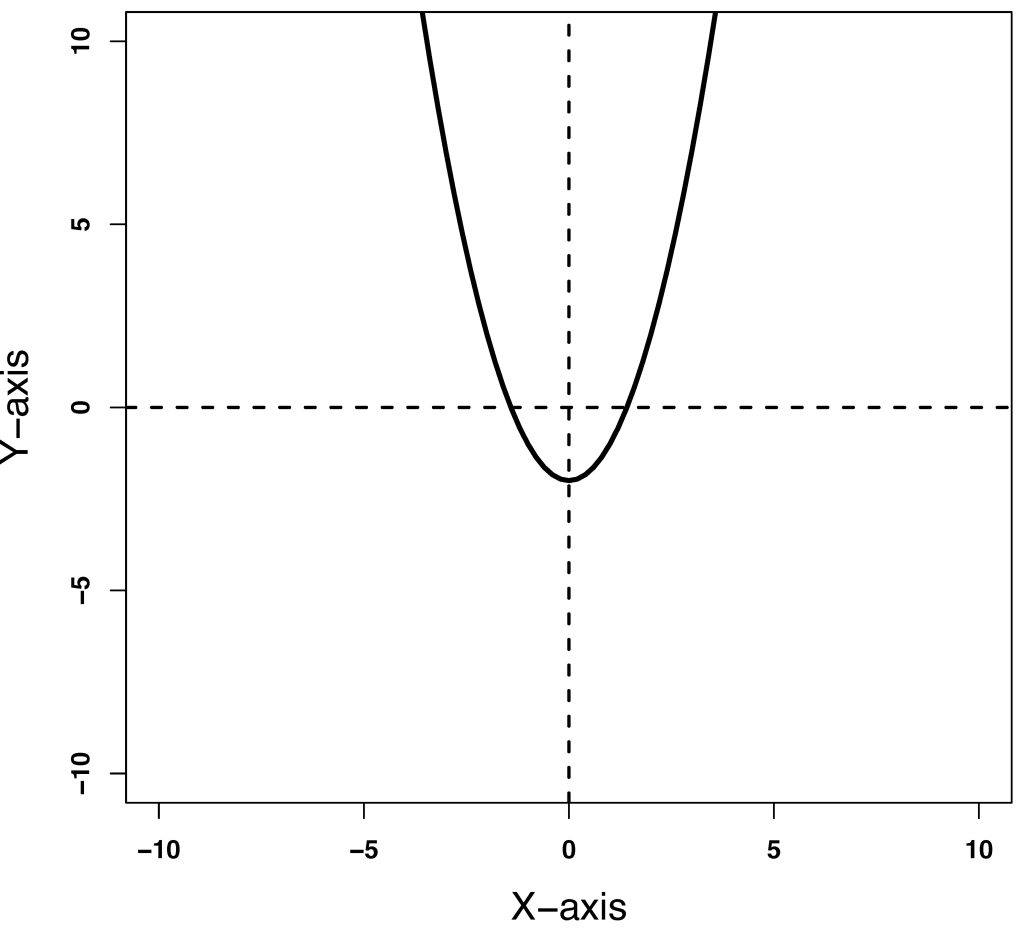
A related study showed that it is spatial competencies and not whether the student is a boy or a girl that contributes to these types of sex differences. Mental rotation is a commonly used measure of spatial abilities, and higher scores are associated with higher standardised mathematics achievement (Numerical Operations Test). As the figure below shows, the relation is the same for boys and girls (shown by parallel lines). In other words, girls with strong spatial competencies do as well on spatial-influenced mathematics measures as boys with the same level of spatial competencies.[34]
Higher Spatial Abilities (Mental Rotation Test) Predict Higher Mathematics Achievement (Numerical Operations) for Boys and Girls.
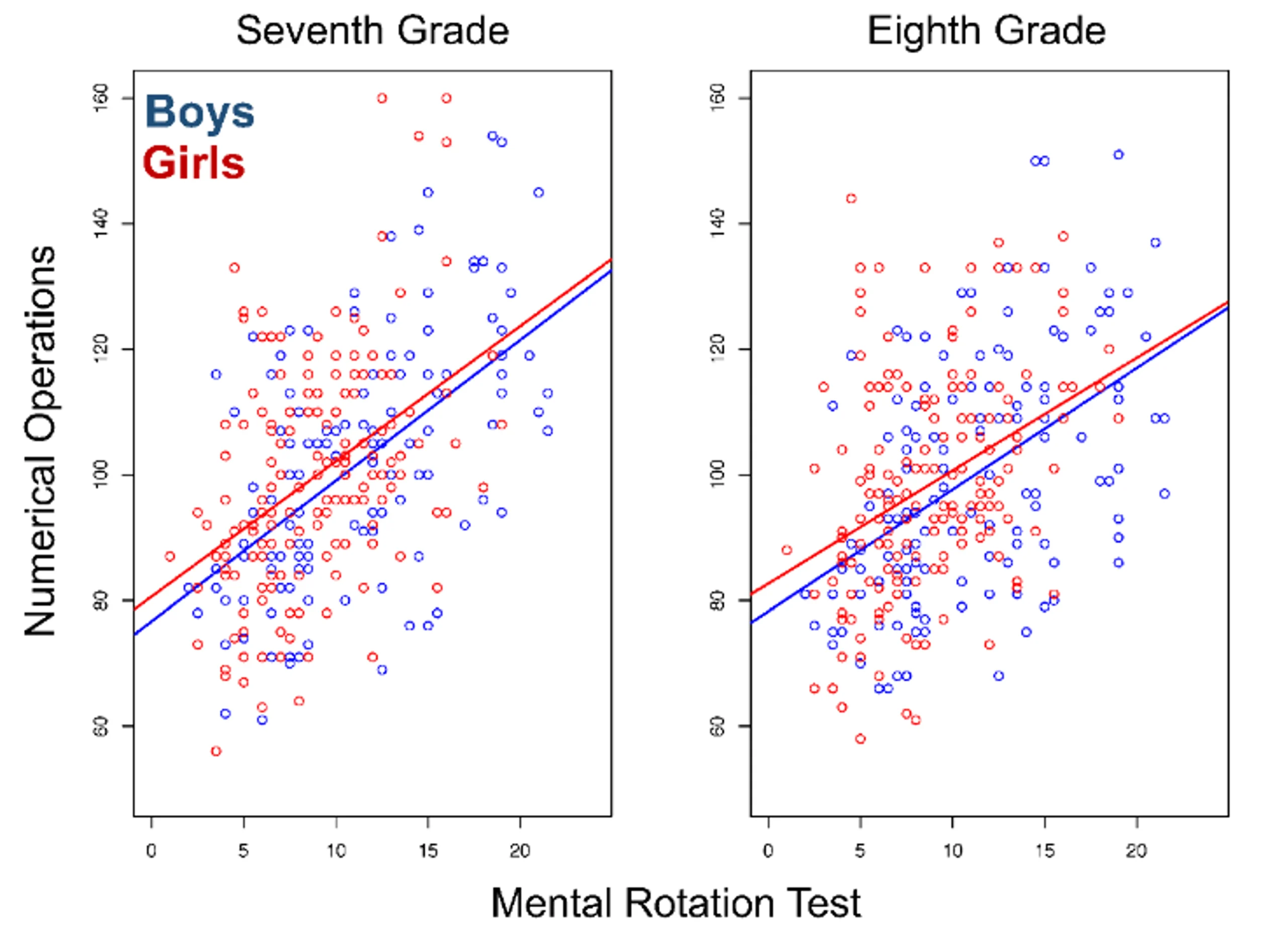
The open circles are individual children (boys are blue and girls are red), and lines represent the overall relation between spatial competencies represented by the mental rotation test and performance on the standardised (Mean = 100) Numerical Operations Test for 7th and 8th grade (year 8). From Geary et al. (2021, Journal of Experimental Child Psychology, 211, p. 12)
Non-Cognitive Contributors to Sex Differences in Mathematics
Several non-cognitive contributors to sex differences in mathematics have been proposed, including stereotype threat, implicit bias, microaggressions, mathematics self-efficacy and utility beliefs, and mathematics anxiety. Stereotype threat occurs when one is confronted with tasks or situations that trigger negative stereotypes (e.g., that ‘women are not as proficient at maths as men’) that in turn results in a preoccupation about performing in a way that confirms the stereotype.[35] Critically, the preoccupation is said to undermine actual performance, even when there is no factual basis to the stereotype. Proponents of stereotype threat argue that some significant proportion of the sex differences in mathematics-intensive STEM fields is caused by pervasive negative stereotypes about women’s abilities in these fields that in turn undermines their performance.[36] The main problem with this argument is that the effects of stereotype threat on girls’ and women’s mathematics performance does not replicate and even when effects are found they are too small to be of much practical significance.[37]
The same is true for implicit bias which involves an unconscious association between group membership (e.g., sex) and stereotypical positive or negative attributes that can, in theory, result in prejudicial behaviour toward individuals within that group.[38] The prejudicial behaviour can include microaggressions which are regarded as subtle behaviours (e.g., facial expressions) or statements that are not explicitly hostile but are nevertheless interpreted by the receiver as conveying contempt, stereotypical attitudes, or other negative beliefs.
Implicit bias is typically assessed using the implicit associations test, whereby the strength of people’s associations between sex and certain attributes, such as work or science, is assessed by a series of categorisation tasks. The difference between the speed of categorising certain attributes (e.g., scientist, engineer) to one sex or the other is taken as an index of implicit bias. Nosek and colleagues found that people are generally quicker to associate men with science and women with literature, which could be interpreted as an implicit bias against women in science, although they concede that the pattern may simply reflect people’s knowledge of actual occupational sex differences.[39] Even if it reflects some type of bias, performance on these implicit bias measures is not consistently related to actual prejudicial behaviour.[40] There are also serious issues with the measurement and interpretation of microaggressions that lead to doubts about their importance in most contexts.[41]
Moreover, a recent adversarial review of bias in STEM fields concluded that women and men in various science domains are treated equally in terms of hiring, grant awards, and in publishing their research, although women receive on average lower teaching evaluations. If anything, women are slightly favoured for hiring into mathematics-intensive STEM positions.[42]
Mathematics self-efficacy represents positive self-appraisals about one’s mathematical competencies and utility beliefs represent an assessment of the long-term usefulness of mathematics. Higher self-efficacy and utility beliefs correlate with higher mathematics achievement and predict future enrolment in mathematics courses in secondary school and higher education.[43]
It appears that the relation between utility beliefs and mathematics achievement is reciprocal, that is, higher achievement leads to higher utility beliefs, and the latter leads to more mathematics course taking. However, prior achievement is often a stronger predictor of later utility than utility is of later achievement for boys and girls, indicating that cause-effect relations are not fully understood.[44] In any case, initial studies suggested that boys had stronger utility beliefs than girls, but recent studies indicate more nuance.[45] Mean differences are smaller than they once were, but boys’ utility beliefs may be more strongly driven by future job aspirations and girls’ beliefs by mathematics courses they expect to take in the future. [46] Across grades, utility beliefs generally decline for both sexes, but higher achieving boys might be more buffered from these declines than similarly achieving girls, possibly because boys who excel in mathematics see this as an area of competitive advantage.[47]
At the same time, boys typically have modestly higher mathematics self-efficacy — 57% of boys have higher self-efficacy than the average girl.[48] Sheu and colleagues’ meta-analysis revealed that mathematics self-efficacy is related in part to prior experiences with mathematics, but cause-effect relations could not be determined from their analysis.[49] One meta-analysis of longitudinal studies indicated a modest relation between students’ academic self-efficacy and their later grades or achievement in the same domain, but prior self-efficacy and achievement levels were not controlled in most of the studies included in this analysis.[50] Studies controlled for these prior relations suggest reciprocal effects for adults, that is, mathematics achievement contributes to self-efficacy and the latter contributes to further engagement with mathematics and through this higher achievement.[51] However, for elementary (primary) and older students, prior achievement seems to be more strongly related to later self-efficacy than self-efficacy is to later achievement.
The overall results suggest that mathematics achievement has a stronger influence on mathematics utility beliefs and self-efficacy than the reverse, and that these relations are similar for girls and boys, although the extent to which these relations might differ for boys and girls has not been systematically studied. As students move through schooling, a reciprocal relation may emerge between mathematics achievement and associated utility beliefs and self-efficacy. Utility beliefs along with self-efficacy are important because they can influence future course taking and consideration of mathematics-intensive fields as a potential career option, but the extent to which these contribute to sex differences in STEM fields is not fully understood.
Sex differences in mathematics anxiety are more firmly established, as is a negative relation between mathematics anxiety and mathematics achievement and avoidance of mathematics.[52] These relations are found in both sexes, but the long-term effects might be more severe for girls and women because they experience higher levels of mathematics anxiety than do boys and men.[53] As with spatial competencies and mathematics, boys with higher mathematics anxiety are just as likely to suffer negative consequences as girls with higher mathematics anxiety. The sex difference effect emerges because girls are more likely to develop anxiety and avoidance of mathematics with exposure to stressful events, such as exams.[54]
Cause-and-effect relations are uncertain, but it appears that prior mathematics achievement is more strongly related to later anxiety than prior mathematics anxiety is to later achievement, although reciprocal effects sometimes emerge.[55] Across grades, mathematics anxiety increases as content becomes more difficult, but like utility beliefs, high achieving boys might be more buffered from these declines than high achieving girls.[56] At this point, no definitive conclusions can be drawn about sex differences in the patterns of relations between mathematics achievement and anxiety, but if anything the effects are likely to compromise girls’ mathematics development more strongly than that of boys.
In-Class Attentive Behaviour and Sex Differences in Mathematics
Behavioural observations and teacher reports of in-class attentive behaviour reveal a consistent relation to academic achievement, including mathematics.[57] In one observational study, Stigler and colleagues found that students (USA) with frequent inattentive behaviours (e.g., out of seat) had consistently lower mathematics achievement (r = -47), while their more attentive peers (e.g., looking at teacher) had higher achievement (r = .37).[58] Geary and colleagues found that teacher reports of in-class attentive behaviour during the elementary or primary school years predicted mathematics outcomes in adolescence, controlling numerous confounds (e.g., working memory, prior mathematics achievement), and the same is found for school-entry attentive behaviour and later mathematics and reading achievement.[59] Attentive behaviour is related to executive functions (e.g., task switching) but is not analogous with them.[60] This is because the ability to maintain attentional focus in classroom settings is related to, but not fully captured by, standard tests of cognitive abilities.[61]
These relations should result in a sex difference in mathematics achievement, favouring girls, given the well-documented sex differences in attentive behaviour, including more boys than girls diagnosed with attention deficit hyperactivity disorder (ADHD).[62] Sex differences (ds = -.35 to -.38) are also found for children and adolescents without ADHD, with inattention (not hyperactivity) being the best indicator of achievement in school-age children and adolescents.[63]
Teacher ratings of attentive behaviour are equally predictive of girls’ and boys’ academic achievement, indicating the ratings are not biased against boys, and show similar variability, heritability estimates (> 70%), and longitudinal stability in boys and girls.[64] An example of sex differences in in-class attentive behaviour is shown in the figure below, where teachers rated the behaviour of the student relative to other students of the same age on a 1 (far below) to 7 (far above) scale (e.g., “Gives close attention to detail and avoids careless mistakes”).[65] As can be seen in the next figure, there are more boys than girls with below average scores and more girls than boys with above average scores.
These differences likely contribute to girls’ advantages in learning school-taught algorithms and their advantages on problems that can be solved with them.[66] On the basis of these patterns, cumulative and widening achievement gaps, favouring girls, might be expected. It is the case that girls and women typically earn higher grades in mathematics courses, but they do not have advantages on mathematics achievement measures. [67] A potential reason for this was found in a 6th-to-9th-grade (Year 7 to 9) longitudinal study.[68] The main findings were that general cognitive abilities (e.g., working memory) were equally important for girls and boys but in-class attentive behaviour contributed more to girls’ than boys’ mathematical development whereas spatial competencies contributed more to boys’ than girls’ mathematical development. In other words, boys’ difficulties with in-class attentive behaviour were compensated by their advantages in spatial competencies.
Histogram of Sex Differences in Teacher-Reported Attentive Behaviour
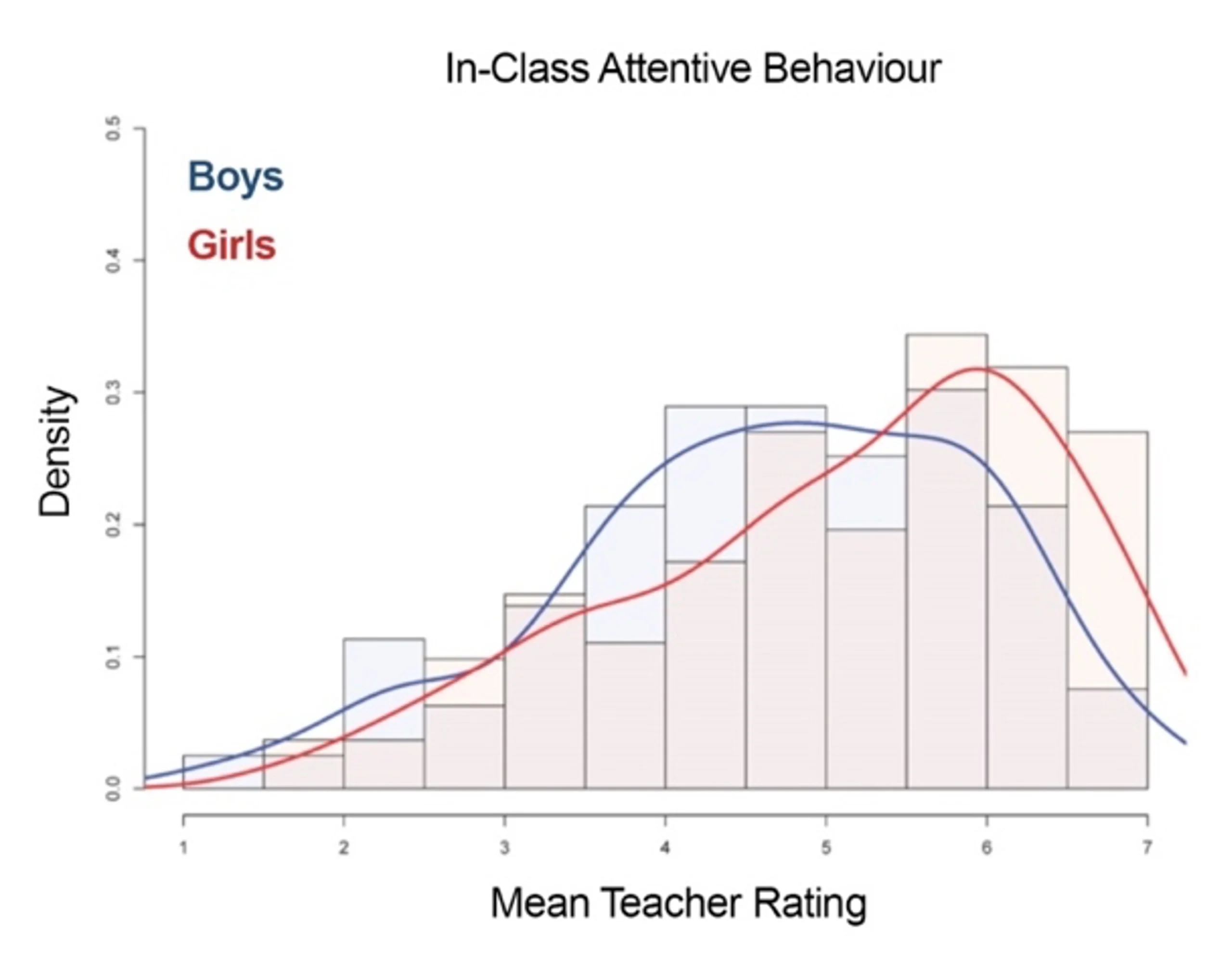
Lower scores mean more difficulties attending in the classroom. From Geary et al. (2021, Journal of Experimental Child Psychology, 211, p. 10)
Implications and Interventions
Sex differences in mathematics achievement receive considerable media and political attention despite mean differences being smaller than those (favouring girls and women) found for reading and writing.[69] The disproportionate attention in STEM subjects in the US is largely driven by political interests (see https://www.aauw.org/issues/education/stem/) whereby blame is attributed to gender bias and discrimination in schools. This, in turn, is driven by more men than women entering mathematics-intensive STEM fields, such as engineering. Common explanations for the sex difference in these fields include stereotype threat, implicit bias, and microaggressions, but there are serious doubts about the relevancy of these issues and a recent review suggests little to no bias (or an advantage for women in some fields) for STEM hiring, grant awards, or research publications.[70]
In Australia, the 2024 Australian government report by the Department of Industry on the state of STEM gender equity (see https://www.industry.gov.au/news/state-stem-gender-equity-2024) shows the number of women enrolling in university STEM courses and working in STEM jobs has increased. However, only 37% of university STEM enrolments are from women, and women represent 15% of all people working in STEM jobs. Yet governments continue to persist with policies pushing for more gender equity in STEM education and careers despite many women choosing not to enter these fields.
A more likely contributor to sex differences in mathematics-intensive fields is that there are 2 to 4 times as many men as women at the very high end of mathematics performance, and more boys and men than girls and women with mathematics as an academic strength. Both absolute levels of mathematics competencies and having mathematics as a strength contribute to pursuit and success in mathematics-intensive STEM fields and thus it is not surprising that more men than women enter and excel in these fields. More men than women pursuing occupations in these fields is also related to sex differences in occupations related to things (higher in men) and people (higher in women), but this is beyond the scope of the current document. [71]
Even though sex differences in mean mathematics scores are small, there are larger differences in specific domains. Areas in which boys and men have advantages appear to be in large part related to the sex differences in spatial competencies. These competencies can be improved with experience and training (example below), but the extent to which these improvements result in gains in mathematics has not been extensively explored. A recent meta-analysis of the studies that have been conducted suggests that spatial training, under some conditions, can lead to gains in mathematics outcomes, but boys and girls benefit equally and thus these types of interventions might not reduce the mathematics achievement gap.72
The overall effect indicated that about 60% of students who received spatial training performed better on one or more mathematics outcomes than comparable students who did not receive the training.72 The effects were larger for adolescents than children and larger with the use of concrete materials and in mathematics domains that had a direct spatial component. As an example, an origami-based intervention, where students engaged in systematic paperfolding to create shapes and figures (see figure below), revealed gains in spatial-related mathematics vocabulary, reductions in mathematics anxiety, and gains in geometry but not arithmetic.73 These types of results are promising and could reduce the sex difference in spatial-related mathematics domains, but the extent to which any such gains fade over time is not yet known.
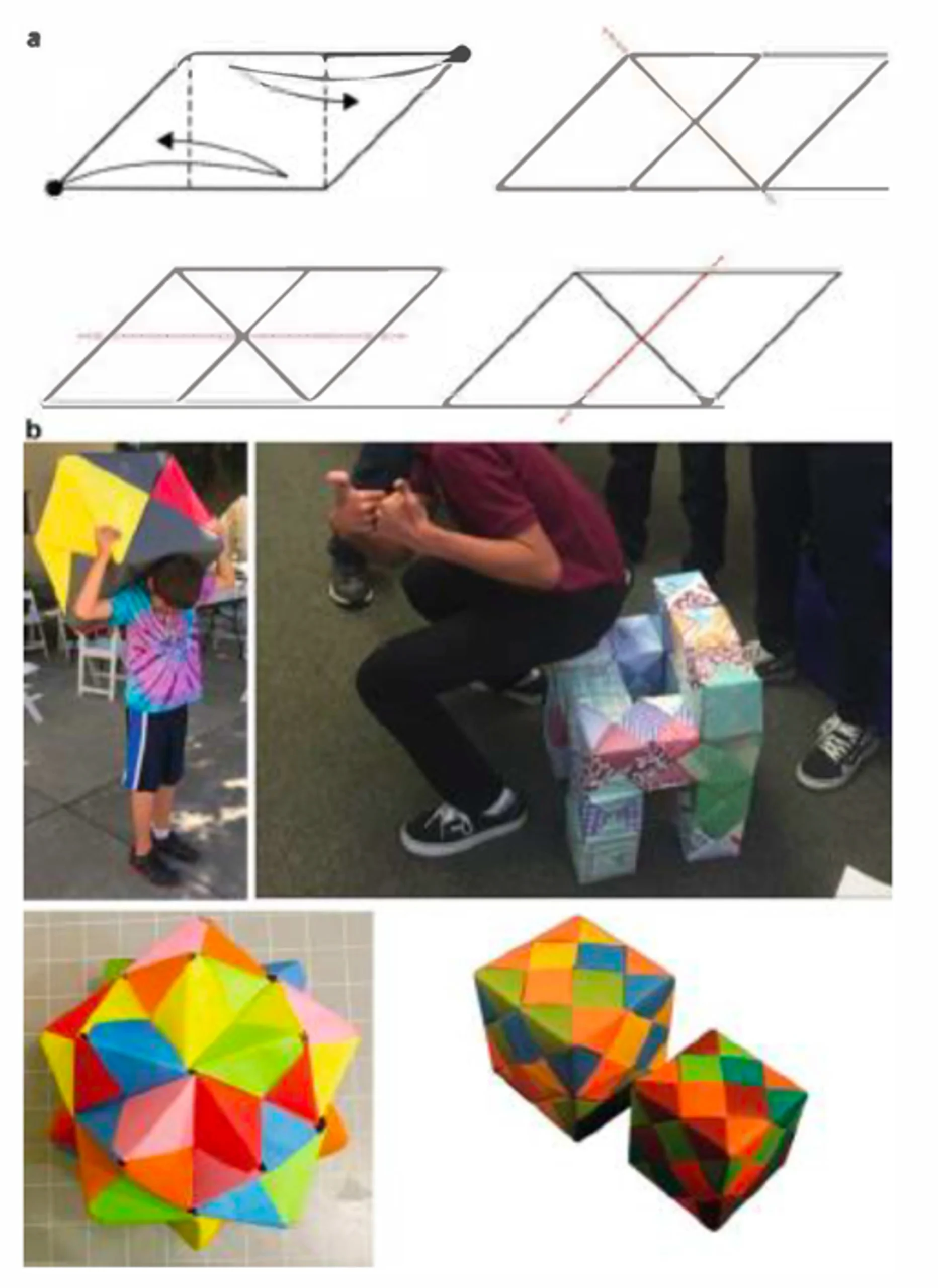
The top (a) shows different ways to fold paper to form a basic origami unit. The second (b) shows some examples. From Li et al. (2023), p. 9. 73
Although cause-effect relations are not fully understood, it is plausible that reductions in mathematics anxiety will result in more mathematics course taking in secondary school and higher education, as well as better exam performance in high-anxious students, which includes more girls than boys. Mathematics is an evolutionary novel domain and thus anxiety associated with it must have a learned component to it, called a conditioned fear response. If so, then repeated success with mathematics should contribute to fear extinction or a reduction in mathematics anxiety over time. Indeed, success with mathematics in middle (Year 7) and secondary school reduced the rise in mathematics anxiety common in these grades, but the effect was larger in boys than girls.74
A recent meta-analysis indicated that interventions focused on cognitive support (e.g., teaching problem solving strategies to improve math problem solving) and emotion regulation (e.g., use of relaxation techniques), but not interventions focused on motivation, show promise in reducing mathematics anxiety and through this improving mathematics performance.75 About 70 percent of students in cognitive support and emotion regulation interventions showed greater reduction in mathematics anxiety than did comparable students in control (no intervention) conditions. Reductions in mathematics anxiety were associated with gains in mathematics performance, but the effects were largest for cognitive support, suggesting that improving mathematics competencies or problem-solving approaches is the most effective route to reducing anxiety.
Interventions focused on enhancing spatial competencies and reducing mathematics anxiety will likely benefit most students, but potentially more girls than boys given the sex differences in these areas. Classroom management interventions, such as seating students where they can be monitored, keeping a consistent classroom structure and routine, will likely improve mathematics outcomes for students with poor in-class attentive behaviour, but in this case potentially benefitting more boys than girls.76 These interventions also include contingency- or consequence-based strategies that can be implemented in classroom settings (e.g., praise for appropriate behaviour, costs for inappropriate behaviour) are often effective in improving attentive behaviour, with more modest effects on academic outcomes.
STEM Policies for the Future
The cognitive and non-cognitive traits that influence interest and success in mathematics-intensive STEM fields have been well documented. These include strong mathematics and spatial competencies, mathematics or science as an academic strength, as well as occupational interests. For these fields an interest in things, such as how machines work, is important.77 National goals to increase the number of high-potential individuals who are prepared for and that enter and excel in these fields should focus on these traits.
Unfortunately, the trend in many countries, including in Australia, is to focus on increasing diversity in STEM fields and not on selecting the highest potential students.78 Tracking individuals into STEM educational programs and fields who are not strong on the long-term predictors of success in these fields (e.g., maths as a best academic subject) will result in a diminution of the nations’ STEM capacities, despite claims to the contrary. A focus on these traits does not mean that there will not be diversity in STEM fields. However, a focus on predictive traits will likely result in a STEM demographic that includes more men than women in mathematics-intensive fields (e.g., engineering), rather than the demographics of the general population.
Endnotes
[1] Bynner, J. M. (1997). Basic skills in adolescents’ occupational preparation. The Career Development Quarterly, 45(4), 305-321. https://doi.org/10.1002/j.2161-0045.1997.tb00536.x; Rivera-Batiz, F. L. (1992). Quantitative literacy and the likelihood of employment among young adults in the United States. Journal of Human Resources, 27(2), 313-328. https://www.jstor.org/stable/145737; Richmond-Rakerd, L. S., D’Souza, S., Andersen, S. H., Hogan, S., Houts, R. M., Poulton, R., & Moffitt, T. E. (2020). Clustering of health, crime and social-welfare inequality in 4 million citizens from two nations. Nature Human Behaviour, 4, 255-264. https://doi.org/10.1038/s41562-019-0810-4
[2] Reilly, D., Neumann, D. L., & Andrews, G. (2015). Sex differences in mathematics and science achievement: A meta-analysis of National Assessment of Educational Progress assessments. Journal of Educational Psychology, 107(3), 645–662. https://doi.org/10.1037/edu0000012; Stoet, G., & Geary, D. C. (2020). Sex-specific academic ability and attitude patterns in students across developed countries. Intelligence, 81, 101453. https://doi.org/10.1016/j.intell.2020.101453
[3] Lindberg, S. M., Hyde, J. S., Petersen, J. L., & Linn, M. C. (2010). New trends in gender and mathematics performance: a meta-analysis. Psychological Bulletin, 136(6), 1123–1135. https://doi.org/10.1037/a0021276; Stoet, G., & Geary, D. C. (2013). Sex differences in mathematics and reading achievement are inversely related: Within- and across-nation assessment of 10 years of PISA data. PLoS ONE, 8(3), e57988. https://doi.org/10.1371/journal.pone.0057988
[4] Stoet, G., & Geary, D. C. (2015). Sex differences in academic achievement are not related to political, economic, or social equality. Intelligence, 48, 137–151. https://doi.org/10.1016/j.intell.2014.11.006; Wai, J., Hodges, J., & Makel, M. C. (2018). Sex differences in ability tilt in the right tail of cognitive abilities: A 35-year examination. Intelligence, 67, 76–83. https://doi.org/10.1016/j.intell.2018.02.003
[5] Lubinski, D., & Benbow, C. P. (2006). Study of mathematically precocious youth after 35 years: Uncovering antecedents for the development of math-science expertise. Perspectives on Psychological Science, 1(4), 316-345. https://doi.org/10.1111/j.1745-6916.2006.00019.x; UNESCO. (2024). Global education monitoring report 2024, gender report: technology on her terms. https://unesdoc.unesco.org/ark:/48223/pf0000389406?posInSet=3&queryId=N-EXPLORE-8f0746e5-6a82-40e0-ae72-80512c303fd3
[6] Bernstein, B. O., Lubinski, D., & Benbow, C. P. (2019). Psychological constellations assessed at age 13 predict distinct forms of eminence 35 years later. Psychological Science, 30(3), 444-454. https://doi.org/10.1177/0956797618822524; Dekhtyar, S., Weber, D., Helgertz, J., & Herlitz, A. (2018). Sex differences in academic strengths contribute to gender segregation in education and occupation: A longitudinal examination of 167,776 individuals. Intelligence, 67, 84-92. https://doi.org/10.1016/j.intell.2017.11.007; Humphreys, L. G., Lubinski, D., & Yao, G. (1993). Utility of predicting group membership and the role of spatial visualization in becoming an engineer, physical scientist, or artist. Journal of Applied Psychology, 78, 250-261. https://doi.org/10.1037/0021-9010.78.2.250
[7] Else-Quest, N. M., Hyde, J. S., & Linn, M. C. (2010). Cross-national patterns of gender differences in mathematics: A meta-analysis. Psychological Bulletin, 136, 103-127. https//doi.org/10.1037/a0018053; Hyde, J. S., Fennema, E., & Lamon, S. (1990). Gender differences in mathematics performance: A meta-analysis. Psychological Bulletin, 107, 139–155. https//doi.org/10.1037/0033-2909.107.2.139
[8] Stoet, G., & Geary, D. C. (2013). Sex differences in mathematics and reading achievement are inversely related: Within- and across-nation assessment of 10 years of PISA data. PLoS ONE, 8(3), e57988. https://doi.org/10.1371/journal.pone.0057988
[9] Reilly D., Neumann, D. L., & Andrews G. (2015). Sex differences in mathematics and science achievement: A meta-analysis of National Educational Progress assessments. Journal of Educational Psychology 107(3), 645-662. https://doi.org/10.1037/edu0000012
[10] Hedges, L. V., & Nowell, A. (1995). Sex differences in mental test scores, variability, and numbers of high-scoring individuals. Science, 269(5220), 41-45. https//doi.org/10.1126/science.7604277
[11] Reilly, D., Neumann, D. L., & Andrews, G. (2015). Sex differences in mathematics and science achievement: A meta-analysis of National Assessment of Educational Progress assessments. Journal of Educational Psychology, 107(3), 645-662. https://doi.org/10.1037/edu0000012; Stoet, G., & Geary, D. C. (2013). Sex differences in mathematics and reading achievement are inversely related: Within- and across-nation assessment of 10 years of PISA data. PLoS ONE, 8(3), e57988. https://doi.org/10.1371/journal.pone.0057988
[12] Wernert, N., Schmid, M., & Rodrigues, S. (2024). TIMSS 2023 Australia. Volume 1: Student performance. Australian Council for Educational Research. https://doi.org/10.37517/978-1-74286-755-7
[13] Wai, J., Cacchio, M., Putallaz, M., & Makel, M. C. (2010). Sex differences in the right tail of cognitive abilities: A 30 year examination. Intelligence, 38(4), 412-423. https://doi.org/10.1016/j.intell.2010.04.006
[14] Eccles, J. (1983). Expectancies, values, and academic behaviors. In J. T. Spence (Ed.), Achievement and achievement motives: Psychological and sociological approaches (pp. 75–146). San Francisco, CA: W. H. Freeman; Dekhtyar, S., Weber, D., Helgertz, J., & Herlitz, A. (2018). Sex differences in academic strengths contribute to gender segregation in education and occupation: A longitudinal examination of 167,776 individuals. Intelligence, 67, 84-92. https://doi.org/10.1016/j.intell.2017.11.007; Humphreys, L. G., Lubinski, D., & Yao, G. (1993). Utility of predicting group membership and the role of spatial visualization in becoming an engineer, physical scientist, or artist. Journal of Applied Psychology, 78, 250-261. https://doi.org/10.1037/0021-9010.78.2.250
[15] Stoet, G., & Geary, D. C. (2018). The gender-equality paradox in science, technology, engineering, and mathematics education. Psychological Science, 29, 581-593 https://doi.org/10.1177/0956797617741719; Balducci, M., Larose, M. P., Stoet, G., & Geary, D. C. (2024). The gender equality paradox in reading and science intraindividual academic strengths: A cross-temporal analysis. Psychological Science, 35, 1246–1259. https://doi.org/10.1177/09567976241271330
[16] Wai, J., Hodges, J., & Makel, M. C. (2018). Sex differences in ability tilt in the right tail of cognitive abilities: A 35-year examination. Intelligence, 67, 76-83. https://doi.org/10.1016/j.intell.2018.02.003
[17] Dekhtyar, S., Weber, D., Helgertz, J., & Herlitz, A. (2018). Sex differences in academic strengths contribute to gender segregation in education and occupation: A longitudinal examination of 167,776 individuals. Intelligence, 67, 84-92. https://doi.org/10.1016/j.intell.2017.11.007
[18] Hyde, J. S., Fennema, E., & Lamon, S. J. (1990). Gender differences in mathematics performance: a meta-analysis. Psychological Bulletin, 107(2), 139-155. https://doi.org/10.1037/0033-2909.107.2.139; see also Lindberg, S. M., Hyde, J. S., Petersen, J. L., & Linn, M. C. (2010). New trends in gender and mathematics performance: A meta-analysis. Psychological Bulletin, 136(6), 1123–1135. https://doi.org/10.1037/a0021276
[19] Caviola, S., Giofrè, D., Toffalini, E., Esposito, L., Tonizzi, I., & Geary, D. C. Sex differences in mathematics: A meta-analytic review across content, grades, and geographic regions. Under editorial review.
[20] Halpern, D., Benbow, C., Geary, D. C., Gur, R., Hyde, J., & Gernsbacher, M. A. (2007). The science of sex differences in science and mathematics. Psychological Science in the Public Interest, 8 (No 1, 1-52). doi:10.1111/j.1529-1006.2007.00032.x; Hawes, Z., & Ansari, D. (2020). What explains the relationship between spatial and mathematical skills? A review of evidence from brain and behavior. Psychonomic Bulletin & Review, 27, 465-482. https://doi.org/10.3758/s13423-019-01694-7; Mix, K. S. (2019). Why are spatial skill and mathematics related? Child Development Perspectives, 13, 121-126. https://doi: 10.1111/cdep12323; Geary, D. C. (2022). Sex, brain, and mathematics: An evolutionary perspective. Developmental Review, 63. 101010. https://doi.org/10.1016/j.dr.2021.101010; Casey, B. M., & Ganley, C. M. (2021). An examination of gender differences in spatial skills and math attitudes in relation to mathematics success: A bio-psycho-social model. Developmental Review, 60, 100963. https://doi.org/10.1016/j.dr.2021.100963
[21] Casey, M. B., Nuttall, R. L., & Pezaris, E. (1997). Mediators of gender differences in mathematics college entrance test scores: A comparison of spatial skills with internalized beliefs and anxieties. Developmental Psychology, 33, 669-680. doi:10.1037/0012-1649.33.4.669; Geary, D. C., & Burlingham-Dubree, M. (1989). External validation of the strategy choice model for addition. Journal of Experimental Child Psychology, 47, 175-192. https://doi.org/10.1016/0022-0965(89)90028-3; Kyttälä, M., & Lehto, J. E. (2008). Some factors underlying mathematical performance: The role of visuospatial working memory and non-verbal intelligence. European Journal of Psychology of Education, 23, 77-94. https://doi.org/10.1007/BF03173141; Mix, K. S., Levine, S. C., Cheng, Y. L., Young, C., Hambrick, D. Z., Ping, R., & Konstantopoulos, S. (2016). Separate but correlated: The latent structure of space and mathematics across development. Journal of Experimental Psychology: General, 145, 1206-1227. doi: 10.1037/xge0000182; Verdine, B. N., Golinkoff, R. M., Hirsh‐Pasek, K., & Newcombe, N. S. (2017). I. Spatial skills, their development, and their links to mathematics. Monographs of the Society for Research in Child Development, 82, 7-30. https://doi.org/10.1111/mono.12280; Delage, V., Daker, R. J., Trudel, G., Lyons, I. M., & Maloney, E. A. (2024). It is a “small world”: Relations between performance on five spatial tasks and five mathematical tasks in undergraduate students. Canadian Journal of Experimental Psychology/Revue Canadienne de Psychologie Expérimentale, 78(4), 256-274. https://doi.org/10.1037/cep0000329
[22] Humphreys, L. G., Lubinski, D., & Yao, G. (1993). Utility of predicting group membership and the role of spatial visualization in becoming an engineer, physical scientist, or artist. Journal of Applied Psychology, 78, 250-261. https://doi.org/10.1037/0021-9010.78.2.250; Kell, H. J., Lubinski, D., Benbow, C. P., & Steiger, J. H. (2013). Creativity and technical innovation: Spatial ability’s unique role. Psychological Science, 24, 1831-1836. https://doi.org/10.1177/0956797613478615; Wai, J., Lubinski, D., & Benbow, C.P. (2009). Spatial ability for STEM domains: Aligning over fifty years of cumulative psychological knowledge solidifies its importance. Journal of Educational Psychology, 101, 817-835. https://doi.org/10.1037/a0016127
[23] Collaer, M. L., & Nelson, J. D. (2002). Large visuospatial sex difference in line judgment: Possible role of attentional factors. Brain and Cognition, 49, 1-12. https://; Nazareth, A., Huang, X., Voyer, D., & Newcombe, N. (2019). A meta-analysis of sex differences in human navigation skills. Psychonomic Bulletin & Review, 26, 1503-1528. https://doi.org/10.3758/s13423-019-01633-6; Voyer, D., Voyer, S., & Bryden, M.P. (1995). Magnitude of sex differences in spatial abilities: A meta-analysis and consideration and consideration of critical variables. Psychological Bulletin, 117, 250-270. https://doi.org/10.1037/0033-2909.117.2.250; Voyer, D., Voyer, S. D., & Saint-Aubin, J. (2017). Sex differences in visual-spatial working memory: A meta-analysis. Psychonomic Bulletin & Review, 24, 307-334. https://doi.org/10.3758/s13423-016-1085-7
[24] Voyer, D., Postma, A., Brake, B., & Imperato-McGinley, J. (2007). Gender differences in object location memory: A meta-analysis. Psychonomic Bulletin & Review, 14, 23-38. https://doi.org/10.3758/BF03194024
[25] Lauer, J. E., Yhang, E., & Lourenco, S. F. (2019). The development of gender differences in spatial reasoning: A meta-analytic review. Psychological Bulletin, 145, 537-565. https://doi.org/10.1037/bul0000191; Levine, S. C., Huttenlocher, J., Taylor, A., & Langrock, A. (1999). Early sex differences in spatial skill. Developmental Psychology, 35, 940-949. https://doi.org/10.1037/0012-1649.35.4.940
[26] Casey, B. M., & Ganley, C. M. (2021). An examination of gender differences in spatial skills and math attitudes in relation to mathematics success: A bio-psycho-social model. Developmental Review, 60, 100963. https://doi.org/10.1016/j.dr.2021.100963; Casey, M. B., Nuttall, R. L., & Pezaris, E. (1997). Mediators of gender differences in mathematics college entrance test scores: A comparison of spatial skills with internalized beliefs and anxieties. Developmental Psychology, 33, 669-680. https://doi.org/10.1037/0012-1649.33.4.669; Mix, K. S., Levine, S. C., Cheng, Y. L., Young, C., Hambrick, D. Z., Ping, R., & Konstantopoulos, S. (2016). Separate but correlated: The latent structure of space and mathematics across development. Journal of Experimental Psychology: General, 145, 1206-1227. https://doi.org/10.1037/xge0000182
[27] Gallagher, A. M., & De Lisi, R. (1994). Gender differences in Scholastic Aptitude Test: Mathematics problem solving among high-ability students. Journal of Educational Psychology, 86, 204–211. https://doi.org/10.1037/0022-0663.86.2.204
[28] Lewis, A. B., & Mayer, R. E. (1987). Students’ miscomprehension of relational statements in arithmetic word problems. Journal of Educational Psychology, 79, 363–371. https://doi.org/10.1037/0022-0663.79.4.363
[29] Casey, M. B., Nuttall, R. L., & Pezaris, E. (1997). Mediators of gender differences in mathematics college entrance test scores: A comparison of spatial skills with internalized beliefs and anxieties. Developmental Psychology, 33, 669-680. https://doi.org10.1037/0012-1649.33.4.669
[30] Lombardi, C. M., Casey, B. M., Pezaris, E., Shadmehr, M., & Jong, M. (2019). Longitudinal analysis of associations between 3-D mental rotation and mathematics reasoning skills during middle school: Across and within genders. Journal of Cognition and Development, 20, 487-509. https://doi.org/10.1080/15248372.2019.1614592
[31] Vasilyeva, M., Casey, B. M., Dearing, E., & Ganley, C. M. (2009). Measurement skills in low-income elementary school students: Exploring the nature of gender differences. Cognition and Instruction, 27, 401-428. https://doi.org/10.1080/07370000903221809
[32] Bull, R., Cleland, A. A., & Mitchell, T. (2013). Sex differences in the spatial representation of number. Journal of Experimental Psychology: General, 142, 181-192. https://doi.org/10.1037/a0028387; Geary, D. C., Scofield, J. E., Hoard, M. K., & Nugent, L. (2021). Boys’ advantage on the fractions number line is mediated by visuospatial attention: Evidence for a parietal-spatial contribution to number line learning. Developmental Science, 24, e13063. https://doi.org/10.1111/desc.13063; Gilligan, K. A., Hodgkiss, A., Thomas, M. S., & Farran, E. K. (2019). The developmental relations between spatial cognition and mathematics in primary school children. Developmental Science, 22, e12786. https://doi.org/10.1111/desc.12786; Hutchison, J. E., Lyons, I. M., & Ansari, D. (2019). More similar than different: Gender differences in children’s basic numerical skills are the exception not the rule. Child Development, 90, e66-e79. https://doi.org/10.1111/cdev.13044
[33] Geary, D. C., Hoard, M. K., & Nugent, L. (2023). Boys’ advantage in solving algebra word problems is mediated by spatial abilities and mathematics anxiety. Developmental Psychology, 59, 413–430. https://doi.org/10.1037/dev0001450; Geary, D. C., Hoard, M. K., & Nugent, L., & Ünal, Z. E. (2023). Sex differences in developmental pathways to mathematical competence. Journal of Educational Psychology, 115, 212–228. https://doi.org/10.1037/edu0000763
[34] Geary, D. C., Hoard, M. K., & Nugent, L. (2021). Boys’ visuospatial abilities compensate for their relatively poor in-class attentive behavior in learning mathematics. Journal of Experimental Child Psychology, 211, 10522. https://doi.org/10.1016/j.jecp.2021.105222
[35] Spencer, S. J., Steele, C. M., & Quinn, D. M. (1999). Stereotype threat and women’s math performance. Journal of Experimental Social Psychology, 35, 4–28. https://doi.org/10.1006/jesp.1998.1373
[36] Hill, C., Corbett, C., & St Rose, A. (2010). Why so few? Women in science, technology, engineering, and mathematics. Washington, DC: American Association of University Women.
[37] Flore, P. C., & Wicherts, J. M. (2015). Does stereotype threat influence performance of girls in stereotyped domains? A meta-analysis. Journal of School Psychology, 53, 25-44. https://doi.org/10.1016/j.jsp.2014.10.002; Ganley, C. M., Mingle, L. A., Ryan, A. M., Ryan, K., Vasilyeva, M., & Perry, M. (2013). An examination of stereotype threat effects on girls’ mathematics performance. Developmental psychology, 49, 1886-1897. https://doi.org/10.1037/a0031412; Stoet, G., & Geary, D. C. (2012). Can stereotype threat explain the sex gap in mathematics performance and achievement? Review of General Psychology, 16, 93-102. https://doi.org/10.1037/a0026617
[38] Greenwald, A. G., McGhee, D. E., & Schwartz, J. L. (1998). Measuring individual differences in implicit cognition: the implicit association test. Journal of Personality and Social Psychology, 74, 1464-1480. https://doi.org/10.1037/0022-3514.74.6.1464; Greenwald, A. G., Poehlman, T. A., Uhlmann, E. L., & Banaji, M. R. (2009). Understanding and using the Implicit Association Test: III. Meta-analysis of predictive validity. Journal of Personality and Social Psychology, 97, 17-41. https://doi.org/ 10.1037/a0015575
[39] Nosek, B. A., Banaji, M. R., & Greenwald, A. G. (2002). Harvesting implicit group attitudes and beliefs from a demonstration web site. Group Dynamics: Theory, Research, and Practice, 6, 101-115. https://doi.org/10.1037/1089-2699.6.1.101
[40] Oswald, F. L., Mitchell, G., Blanton, H., Jaccard, J., & Tetlock, P. E. (2013). Predicting ethnic and racial discrimination: A meta-analysis of IAT criterion studies. Journal of Personality and Social Psychology, 105, 171-192. https://doi.org/10.1037/a0032734; Greenwald, A. G., Banaji, M. R., & Nosek, B. A. (2015). Statistically small effects of the Implicit Association Test can have societally large effects. Journal of Personality and Social psychology, 108, 553-561. http://doi.org/10.1037/pspa0000016
[41] Lilienfeld, S. O. (2017). Microaggressions: Strong claims, inadequate evidence. Perspectives on Psychological Science, 12(1), 138-169. https://doi.org/10.1177/1745691616659391
[42] Ceci, S. J., Kahn, S., & Williams, W. M. (2023). Exploring gender bias in six key domains of academic science: An adversarial collaboration. Psychological Science in the Public Interest, 24(1), 15-73. https://doi.org/10.1177/15291006231163179
[43] Crombie, G., Sinclair, N., Silverthorn, N., Byrne, B. M., DuBois, D. L., & Trinneer, A. (2005). Predictors of young adolescents’ math grades and course enrollment intentions: Gender similarities and differences. Sex Roles, 52, 351-367. https://doi.org/10.1007/s11199-005-2678-1; Lauermann, F., Tsai, Y. M., & Eccles, J. S. (2017). Math-related career aspirations and choices within Eccles et al.’s expectancy–value theory of achievement-related behaviors. Developmental Psychology, 53, 1540-1559. https://doi.org/10.1037/dev0000367
[44] Ma, X., & Xu, J. (2004). Determining the causal ordering between attitude toward mathematics and achievement in mathematics. American Journal of Education, 110(3), 256–280. https://doi.org/10.1086/383074
[45] Eccles, J. S., Adler, T. F., & Meece, J. L. (1984). Sex differences in achievement: A test of alternative theories. Journal of Personality and Social Psychology, 46, 26-43. https://doi.org/10.1037/0022-3514.46.1.26; Gaspard, H., Dicke, A. L., Flunger, B., Schreier, B., Häfner, I., Trautwein, U., & Nagengast, B. (2015). More value through greater differentiation: Gender differences in value beliefs about math. Journal of Educational Psychology, 107, 663-677. https://doi.org/10.1037/edu0000003; Lauermann, F., Tsai, Y. M., & Eccles, J. S. (2017). Math-related career aspirations and choices within Eccles et al.’s expectancy–value theory of achievement-related behaviors. Developmental Psychology, 53, 1540-1559. https://doi.org/10.1037/dev0000367
[46] Gaspard, H., Dicke, A. L., Flunger, B., Schreier, B., Häfner, I., Trautwein, U., & Nagengast, B. (2015). More value through greater differentiation: Gender differences in value beliefs about math. Journal of Educational Psychology, 107, 663-677. https://doi:10.1037/edu0000003
[47] Geary, D. C., Hoard, M. K., & Nugent, L., Ünal, Z. E., & Greene, N. R. (2023). Sex differences and similarities in relations between mathematics achievement, attitudes, and anxiety: A 7th-to-9th grade longitudinal study. Journal of Educational Psychology, 115, 767-782. https://doi.org/10.1037/edu0000793
[48] Huang, C. (2013). Gender differences in academic self-efficacy: A meta-analysis. European Journal of Psychology of Education 28, 1-35. doi:10.1007/s10212-011-0097-y; Jiang, S., Simpkins, S. D., & Eccles, J. S. (2020). Individuals’ math and science motivation and their subsequent STEM choices and achievement in high school and college: A longitudinal study of gender and college generation status differences. Developmental Psychology, 56, 2137-2151. https://doi.org/10.1037/dev0001110
[49] Sheu, H. B., Lent, R. W., Miller, M. J., Penn, L. T., Cusick, M. E., & Truong, N. N. (2018). Sources of self-efficacy and outcome expectations in science, technology, engineering, and mathematics domains: A meta-analysis. Journal of Vocational Behavior, 109, 118-136. https://doi.org/10.1016/j.jvb.2018.10.003
[50] Valentine, J. C., DuBois, D. L., & Cooper, H. (2004). The relation between self-beliefs and academic achievement: A meta-analytic review. Educational Psychologist, 39, 111-133. https://doi.org/10.1207/s15326985ep3902_3
[51] Talsma, K., Schüz, B., Schwarzer, R., & Norris, K. (2018). I believe, therefore I achieve (and vice versa): A meta-analytic cross-lagged panel analysis of self-efficacy and academic performance. Learning and Individual Differences, 61, 136-150. https://doi.org/10.1016/j.lindif.2017.11.015
[52] Caviola, S., Toffalini, E., Giofrè, D., Ruiz, J. M., Szűcs, D., & Mammarella, I. C. (2022). Math performance and academic anxiety forms, from sociodemographic to cognitive aspects: A meta-analysis on 906,311 participants. Educational Psychology Review, 34(1), 363-399. https://doi.org/10.1007/s10648-021-09618-5; Dowker, A., Sarkar, A., & Looi, C. Y. (2016). Mathematics anxiety: What have we learned in 60 years? Frontiers in Psychology, 7, 508. https://doi.org/10.3389/fpsyg.2016.00508; Hembree, R. (1990). The nature, effects, and relief of mathematics anxiety. Journal for Research in Mathematics Education, 21, 33-46. https://doi.org/10.2307/749455; Ma, X. (1999). A meta-analysis of the relationship between anxiety toward mathematics and achievement in mathematics. Journal for Research in Mathematics Education, 30, 520-540. https://doi.org/10.2307/749772
[53] Hyde, J. S., Fennema, E., Ryan, M., Frost, L. A., & Hopp, C. (1990). Gender comparisons of mathematics attitudes and affect. Psychology of Women Quarterly, 14, 299-324. https://doi.org/10.1111/j.1471-6402.1990.tb00022.x; Stoet, G., Bailey, D. H., Moore, A. M., & Geary, D. C. (2016). Countries with higher levels of gender equality show larger national sex differences in mathematics anxiety and relatively lower parental mathematics valuation for girls. PloS ONE, 11(4): e0153857. https://doi.org/10.1371/journal.pone.0153857
[54] Geary, D. C., Hoard, M. K., & Nugent, L., Ünal, Z. E., & Greene, N. R. (2023). Sex differences and similarities in relations between mathematics achievement, attitudes, and anxiety: A 7th-to-9th grade longitudinal study. Journal of Educational Psychology, 115, 767-782. https://doi.org/10.1037/edu0000793
[55] Gunderson, E. A., Park, D., Maloney, E. A., Beilock, S. L., & Levine, S. C. (2018). Reciprocal relations among motivational frameworks, math anxiety, and math achievement in early elementary school. Journal of Cognition and Development, 19, 21-46. https://doi.org/10.1080/15248372.2017.1421538; Ma, X., & Xu, J. (2004). The causal ordering of mathematics anxiety and mathematics achievement: a longitudinal panel analysis. Journal of Adolescence, 27(2), 165-179. https://doi.org/10.1016/j.adolescence.2003.11.003; Wang, Z., Rimfeld, K., Shakeshaft, N., Schofield, K., & Malanchini, M. (2020). The longitudinal role of mathematics anxiety in mathematics development: Issues of gender differences and domain-specificity. Journal of Adolescence, 80, 220-232. https://doi.org/10.1016/j.adolescence.2020.03.003
[56] Geary, D. C., Hoard, M. K., & Nugent, L., Ünal, Z. E., & Greene, N. R. (2023). Sex differences and similarities in relations between mathematics achievement, attitudes, and anxiety: A 7th-to-9th grade longitudinal study. Journal of Educational Psychology, 115, 767-782. https://doi.org/10.1037/edu0000793
[57] Fuchs, L. S., Fuchs, D., Compton, D. L., Powell, S. R., Seethaler, P. M., Capizzi, A. M., … & Fletcher, J. M. (2006). The cognitive correlates of third-grade skill in arithmetic, algorithmic computation, and arithmetic word problems. Journal of Educational Psychology, 98, 29-46. https://doi.org/10.1037/0022-0663.98.1.29; Gray, S. A., Dueck, K., Rogers, M., & Tannock, R. (2017). Qualitative review synthesis: The relationship between inattention and academic achievement. Educational Research, 59, 17-35. https://doi.org/10.1080/00131881.2016.1274235
[58] Stigler, J. W., Lee, S. Y., & Stevenson, H. W. (1987). Mathematics classrooms in Japan, Taiwan, and the United States. Child Development, 1272-1285. https://doi.org/10.2307/1130620
[59] Duncan, G. J., Dowsett, C. J., Claessens, A., Magnuson, K., Huston, A. C., Klebanov, P., … & Sexton, H. (2007). School readiness and later achievement. Developmental Psychology, 43, 1428-1446. https://doi.org/10.1037/0012-1649.43.6.1428; Geary, D.C., Hoard, M. K., Nugent, L., & Bailey, H. D. (2013). Adolescents’ functional numeracy is predicted by their school entry number system knowledge. PLoS ONE, 8: e54651. https://doi.org/10.1371/journal.pone.0054651
[60] Kasper, L. J., Alderson, R. M., & Hudec, K. L. (2012). Moderators of working memory deficits in children with attention-deficit/hyperactivity disorder (ADHD): A meta-analytic review. Clinical Psychology Review, 32, 605-617. https://doi.org/10.1016/j.cpr.2012.07.001; Nejati, V., Salehinejad, M. A., Nitsche, M. A., Najian, A., & Javadi, A. H. (2020). Transcranial direct current stimulation improves executive dysfunctions in ADHD: implications for inhibitory control, interference control, working memory, and cognitive flexibility. Journal of Attention Disorders, 24, 1928-1943. https://doi.org/10.1177/1087054717730611
[61] Friso-van den Bos, I., & van de Weijer-Bergsma, E. (2020). Classroom versus individual working memory assessment: Predicting academic achievement and the role of attention and response inhibition. Memory, 28, 70-82. https://doi.org/10.1080/09658211.2019.1682170
[62] Willcutt, E. G. (2012). The prevalence of DSM-IV attention-deficit/hyperactivity disorder: A meta-analytic review. Neurotherapeutics, 9, 490-499. https://doi.org/10.1007/s13311-012-0135-8
[63] Arnett, A. B., Pennington, B. F., Willcutt, E. G., DeFries, J. C., & Olson, R. K. (2015). Sex differences in ADHD symptom severity. Journal of Child Psychology and Psychiatry, 56, 632-639. https://doi.org/10.1111/jcpp.12337; Lampert, T. L., Polanczyk, G., Tramontina, S., Mardini, V., & Rohde, L. A. (2004). Diagnostic performance of the CBCL-Attention Problem Scale as a screening measure in a sample of Brazilian children with ADHD. Journal of Attention Disorders, 8, 63-71. https://doi.org/10.1177/108705470400800204; Rietveld, M. J., Hudziak, J. J., Bartels, M., Van Beijsterveldt, C. E. M., & Boomsma, D. I. (2004). Heritability of attention problems in children: Longitudinal results from a study of twins, age 3 to 12. Journal of Child Psychology and Psychiatry, 45, 577-588. https://doi.org/10.1111/j.1469-7610.2004.00247.x
[64] Arnett, A. B., Pennington, B. F., Willcutt, E. G., DeFries, J. C., & Olson, R. K. (2015). Sex differences in ADHD symptom severity. Journal of Child Psychology and Psychiatry, 56, 632-639. https://doi.org/10.1111/jcpp.12337; Rietveld, M. J., Hudziak, J. J., Bartels, M., Van Beijsterveldt, C. E. M., & Boomsma, D. I. (2004). Heritability of attention problems in children: Longitudinal results from a study of twins, age 3 to 12. Journal of Child Psychology and Psychiatry, 45, 577-588. https://doi.org/10.1111/j.1469-7610.2004.00247.x
[65] Geary, D. C., Hoard, M. K., & Nugent, L. (2021). Boys’ visuospatial abilities compensate for their relatively poor in-class attentive behavior in learning mathematics. Journal of Experimental Child Psychology, 211, 10522. https://doi.org/10.1016/j.jecp.2021.105222
[66] Casey, B. M., & Ganley, C. M. (2021). An examination of gender differences in spatial skills and math attitudes in relation to mathematics success: A bio-psycho-social model. Developmental Review, 60, 100963. https://doi.org/10.1016/j.dr.2021.100963; Gallagher, A. M., & De Lisi, R. (1994). Gender differences in Scholastic Aptitude Test: Mathematics problem solving among high-ability students. Journal of Educational Psychology, 86, 204–211. https://doi.org/10.1037/0022-0663.86.2.204
[67] Kimball, M. M. (1989). A new perspective on women’s math achievement. Psychological Bulletin, 105(2), 198–214. https://doi.org/10.1037/0033-2909.105.2.198
[68] Geary, D. C., Hoard, M. K., & Nugent, L., & Ünal, Z. E. (2023). Sex differences in developmental pathways to mathematical competence. Journal of Educational Psychology, 115, 212–228. https://doi.org/10.1037/edu0000763
[69] Reilly, D., Neumann, D. L., & Andrews, G. (2019). Gender differences in reading and writing achievement: Evidence from the National Assessment of Educational Progress (NAEP). American Psychologist, 74(4), 445–458. https://doi.org/10.1037/amp0000356
[70] Ceci, S. J., Kahn, S., & Williams, W. M. (2023). Exploring gender bias in six key domains of academic science: An adversarial collaboration. Psychological Science in the Public Interest, 24(1), 15-73. https://doi.org/10.1177/15291006231163179
[71] Su, R., & Rounds, J. (2015). All STEM fields are not created equal: People and things interests explain gender disparities across STEM fields. Frontiers in Psychology, 6, 189. https://doi.org/10.3389/fpsyg.2015.00189; Su, R., Rounds. J., & Armstrong, P. I. (2009). Men and things, women and people. Psychological Bulletin, 135, 859-884. https://doi.org/10.1037/a0017364; Stoet, G., & Geary, D. C. (2022). Sex differences in adolescents’ occupational aspirations: Variation across time and place. PLoS ONE, 17, e0261438. https://doi.org/10.1371/journal.pone.0261438
72 Hawes, Z. C., Gilligan-Lee, K. A., & Mix, K. S. (2022). Effects of spatial training on mathematics performance: A meta-analysis. Developmental Psychology, 58(1), 112-137. https://doi.org/10.1037/dev0001281; see also Uttal, D. H., Meadow, N. G., Tipton, E., Hand, L. L., Alden, A. R., Warren, C., & Newcombe, N. S. (2013). The malleability of spatial skills: a meta-analysis of training studies. Psychological Bulletin, 139(2), 352 –402. https://doi.org/10.1037/a0028446
73 Ridgley, L. M., Geary, D. C., Li, Y., Myers, P., Ottinger, R., Silvaggio, D. N., Ünal, Z. & Popov, V. The language of folding: Increasing spatial language and decreasing mathematics anxiety through origami. Under editorial review. Li, Y., Meyers, P., Geary, D. C., Robertson, T., & Popov, V. (2023). Fostering visuospatial skills in children through inquiry-based learning with origami: The case study of VisMO lessons. In J. M. Spector, B. B. Lockee and M. D. Childress (Eds), Learning, Design, and Technology. An International Compendium of Theory, Research, Practice, and Policy (pp. 1-32), New York: Springer.
74 Geary, D. C., Hoard, M. K., & Nugent, L., Ünal, Z. E., & Greene, N. R. (2023). Sex differences and similarities in relations between mathematics achievement, attitudes, and anxiety: A 7th-to-9th grade longitudinal study. Journal of Educational Psychology, 115, 767-782. : https://dx.doi.org/10.1037/edu0000793
75 Sammallahti, E., Finell, J., Jonsson, B., & Korhonen, J. (2023). A meta-analysis of math anxiety interventions. Journal of Numerical Cognition, 9(2), 346-362. https://doi.org/10.5964/jnc.8401
76 DuPaul, G. J., & Eckert, T. L. (1997). The Effects of School-based Interventions for Attention Deficit Hyperactivity Disorder: A Meta-Analysis. School Psychology Review, 26(1), 5–27. https://doi.org/10.1080/02796015.1997.12085845; Gaastra, G. F., Groen, Y., Tucha, L., & Tucha, O. (2016). The effects of classroom interventions on off-task and disruptive classroom behavior in children with symptoms of attention-deficit/hyperactivity disorder: A meta-analytic review. PloS one, 11(2), e0148841. https://doi.org/10.1371/journal.pone.0148841; Keilow, M., Holm, A., Friis-Hansen, M., & Kristensen, R. M. (2019). Effects of a classroom management intervention on student selective attention: results from a randomized controlled trial. School Effectiveness and School Improvement, 30(2), 194-211. https://doi.org/10.1080/09243453.2018.1557701; Mulligan, S. (2001). Classroom strategies used by teachers of students with attention deficit hyperactivity disorder. Physical & Occupational Therapy in Pediatrics, 20(4), 25-44. https://doi.org/10.1080/J006v20n04_03
77 Bernstein, B. O., Lubinski, D., & Benbow, C. P. (2019). Psychological constellations assessed at age 13 predict distinct forms of eminence 35 years later. Psychological Science, 30(3), 444-454. https://doi.org/10.1177/0956797618822524; Dekhtyar, S., Weber, D., Helgertz, J., & Herlitz, A. (2018). Sex differences in academic strengths contribute to gender segregation in education and occupation: A longitudinal examination of 167,776 individuals. Intelligence, 67, 84-92. https://doi.org/10.1016/j.intell.2017.11.007; Humphreys, L. G., Lubinski, D., & Yao, G. (1993). Utility of predicting group membership and the role of spatial visualization in becoming an engineer, physical scientist, or artist. Journal of Applied Psychology, 78, 250-261. https://doi.org/10.1037/0021-9010.78.2.250; Kell, H. J., Lubinski, D., Benbow, C. P., & Steiger, J. H. (2013). Creativity and technical innovation: Spatial ability’s unique role. Psychological science, 24(9), 1831-1836. https://doi.org/10.1177/0956797613478615; Lubinski, D., & Benbow, C. P. (2006). Study of mathematically precocious youth after 35 years: Uncovering antecedents for the development of math-science expertise. Perspectives on Psychological Science, 1(4), 316-345. https://doi.org/10.1111/j.1745-6916.2006.00019.x;
78 Williams, S. A., Jade, M., & Kaur, P. (2024). Pathway to diversity in STEM review: Final recommendations. https://apo.org.au/node/325545
